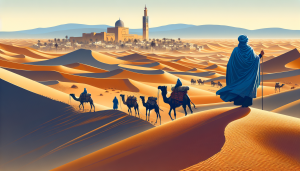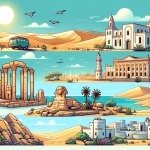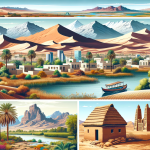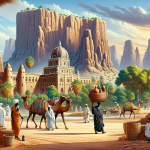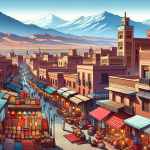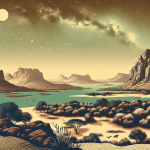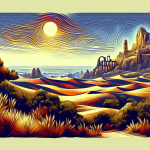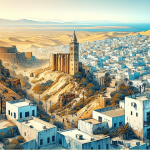A Journey Through the Vast and Intriguing Western Sahara
Western Sahara, a territory located in North Africa with a rich tapestry of history, culture, and natural beauty, remains one of the most enigmatic and lesser-explored regions in the world. For the intrepid traveler, Western Sahara presents a unique opportunity to delve into a land that offers both the allure of the unknown and the charm of the traditional Sahrawi culture. In this expansive travel guide, we will traverse through the sands of Western Sahara, exploring its captivating desert landscapes, vibrant local traditions, and significant historical sites. Whether you’re an adventurous backpacker, a history enthusiast, or simply someone looking to explore a new frontier, Western Sahara has something to offer. This guide will provide you with everything you need to know to plan your journey, from the best times to visit, must-see places, cultural tips, and practical travel advice to ensure you have a fulfilling and memorable experience.
Understanding Western Sahara
Western Sahara, bordered by Morocco to the north, Algeria to the northeast, Mauritania to the east and south, and the Atlantic Ocean to the west, is a region steeped in political complexities and rich cultural history. The territory is primarily desert, characterized by vast stretches of sand dunes, rocky plateaus, and sparse vegetation. Despite its arid environment, Western Sahara is home to a resilient population known as the Sahrawis, who have preserved their cultural heritage and traditions amidst the challenging landscape.
Geographical Overview
Western Sahara’s terrain is predominantly desert, with the Sahara Desert extending into the region. The landscape is dotted with impressive sand dunes, some of which can reach heights of over 500 feet. The climate is harsh, with scorching temperatures during the day and cooler nights. Rainfall is rare, and water sources are limited, making the region one of the most arid places on earth. However, this stark environment is part of what makes Western Sahara so fascinating; it is a land where nature’s extremes are on full display.
Political Context
The political status of Western Sahara is a subject of international debate. The territory was a Spanish colony until 1975, after which it was claimed by both Morocco and the Sahrawi Arab Democratic Republic (SADR). The United Nations considers Western Sahara a non-self-governing territory, and a ceasefire has been in place since 1991, with ongoing negotiations attempting to resolve the dispute. For travelers, it is crucial to stay informed about the current political situation and exercise caution, particularly in border areas.
Top Attractions in Western Sahara
While Western Sahara may not boast the conventional tourist attractions found in more mainstream destinations, it offers a wealth of unique experiences that are sure to captivate any visitor. From breathtaking natural landscapes to culturally significant sites, here are some of the top attractions you should not miss:
Laayoune
Laayoune, the largest city in Western Sahara, serves as the region’s administrative and economic hub. The city offers a mix of modern amenities and traditional Sahrawi culture. Key attractions in Laayoune include the vibrant market, where you can find local crafts and textiles, and the Cathedral of Saint Francis of Assisi, a relic from the Spanish colonial era. Strolling through the streets of Laayoune provides a glimpse into the daily life of the Sahrawi people and their enduring traditions.
Dakhla
Dakhla, a coastal city located on a narrow peninsula jutting into the Atlantic Ocean, is renowned for its stunning natural beauty and outdoor activities. The Dakhla Lagoon is a paradise for water sports enthusiasts, offering excellent conditions for kitesurfing, windsurfing, and fishing. The surrounding desert also provides opportunities for off-road adventures and camel trekking. Dakhla’s unique geography, where the desert meets the ocean, creates a picturesque setting that is truly one-of-a-kind.
Smara
Smara, an inland town with a rich historical and cultural heritage, is an important center for Sahrawi culture. Founded in the early 20th century, Smara is home to several significant sites, including the Smara Mosque and the ruins of an ancient library. The town’s traditional architecture and historical significance make it a fascinating destination for those interested in the region’s past. Smara also hosts annual cultural festivals that celebrate Sahrawi music, dance, and poetry.
The Desert Landscape
Western Sahara’s desert landscape is undoubtedly one of its most compelling attractions. The vast stretches of sand dunes, rocky outcrops, and starkly beautiful vistas create a sense of awe and wonder. Visitors can experience the desert in various ways, from guided jeep tours to camel treks that offer a more traditional mode of travel. Camping under the stars in the Sahara Desert is an unforgettable experience, providing a chance to connect with nature and experience the tranquility of the desert night.
Cultural Insights and Traditions
The Sahrawi people, the indigenous inhabitants of Western Sahara, have a rich cultural heritage that is deeply intertwined with the desert landscape. Understanding and respecting Sahrawi customs and traditions is essential for any visitor to the region.
Traditional Sahrawi Hospitality
Hospitality is a cornerstone of Sahrawi culture. Visitors are often welcomed with open arms and offered traditional tea, known as “atai,” which is a symbol of friendship and hospitality. The preparation and serving of tea is a ritualistic process that involves three servings, each with a different level of sweetness. Participating in a tea ceremony is a way to connect with the local culture and show respect for Sahrawi traditions.
Music and Dance
Music and dance play a significant role in Sahrawi culture. Traditional Sahrawi music features instruments such as the “tidinit” (a type of lute) and the “tbal” (a drum), and is often accompanied by poetic lyrics that tell stories of love, history, and the desert. Dance is also an integral part of Sahrawi celebrations, with performances that showcase the community’s vibrant spirit and cultural pride. Attending a local music and dance event is a must for anyone looking to immerse themselves in the cultural fabric of Western Sahara.
Nomadic Lifestyle
Many Sahrawis continue to maintain a nomadic or semi-nomadic lifestyle, living in traditional tents known as “haimas” and herding camels, goats, and sheep. This way of life is adapted to the harsh desert environment and reflects the deep connection between the Sahrawi people and their land. Understanding the nomadic lifestyle and its significance can provide valuable insights into the resilience and adaptability of the Sahrawi culture.
Planning Your Trip to Western Sahara
When planning a trip to Western Sahara, there are several important considerations to keep in mind to ensure a safe and enjoyable journey.
Best Time to Visit
The best time to visit Western Sahara is during the cooler months, from October to April, when temperatures are more moderate. Daytime temperatures can still be warm, but the evenings and nights are cooler, making it more comfortable for outdoor activities and desert excursions. Avoid traveling during the peak summer months, as temperatures can soar to extreme levels, making it challenging to explore the region.
Travel Permits and Documentation
Traveling to Western Sahara requires careful planning regarding permits and documentation. Depending on the current political situation, you may need to obtain special permits to visit certain areas, particularly those near the border. It’s essential to check the latest travel advisories and consult with local authorities or tour operators to ensure you have the necessary permissions. Additionally, ensure your passport is valid for at least six months beyond your planned stay.
Health and Safety
Health and safety are paramount when traveling to Western Sahara. Given the remote and arid nature of the region, it’s crucial to take precautions to stay healthy and safe. Make sure to stay hydrated by drinking plenty of water and using sun protection such as sunscreen, hats, and sunglasses. It’s also advisable to carry a basic first aid kit and any necessary medications. Stay informed about the political situation and avoid areas with known conflicts or unrest. Always follow the guidance of local authorities and tour operators to ensure a safe and enjoyable trip.
Accommodation and Transportation
Accommodation options in Western Sahara range from basic guesthouses and hotels to more traditional desert camps. In cities like Laayoune and Dakhla, you’ll find a selection of hotels that cater to different budgets. For a more authentic experience, consider staying in a desert camp, where you can sleep in traditional tents and enjoy the tranquility of the desert night. Transportation within Western Sahara can be challenging due to the vast distances and limited infrastructure. Renting a 4×4 vehicle is a popular option for exploring the region, as it allows you to navigate the desert terrain more easily. Alternatively, you can join organized tours that provide transportation and guided experiences.
Local Cuisine
Western Sahara’s cuisine is a reflection of its desert environment and nomadic traditions. Meals are often simple yet flavorful, with a focus on locally sourced ingredients. One of the most popular dishes is “mechoui,” a slow-roasted lamb that is tender and flavorful. Another staple is “couscous,” a dish made from steamed semolina grains and served with vegetables and meat. Seafood is also a significant part of the diet, particularly in coastal areas like Dakhla, where fresh fish and shellfish are readily available. Don’t miss the opportunity to try “harira,” a traditional soup made with lentils, chickpeas, and tomatoes, often enjoyed during the evening meal.
Responsible Travel in Western Sahara
When traveling to Western Sahara, it’s important to practice responsible travel to respect the local culture and environment.
Supporting Local Communities
One of the best ways to support the local economy and community is by purchasing goods and services from local businesses. This includes buying handicrafts, textiles, and other products directly from artisans and vendors. Additionally, consider staying in locally owned accommodations and dining at local restaurants to contribute to the local economy.
Environmental Considerations
Western Sahara’s fragile desert ecosystem requires careful consideration to minimize your environmental impact. Avoid leaving any waste behind, and dispose of garbage responsibly. Use reusable water bottles and bags to reduce plastic waste. If you’re camping in the desert, follow the Leave No Trace principles to ensure you don’t disturb the natural environment. Respecting the natural landscape is essential to preserving its beauty for future generations.
Cultural Sensitivity
Respect for local customs and traditions is crucial when visiting Western Sahara. Dress modestly, particularly in rural and conservative areas, to show respect for local norms. Always ask for permission before taking photographs of people, particularly women, and be mindful of cultural sensitivities. Engaging with the local community in a respectful and open-minded manner can enrich your travel experience and foster positive interactions.
Conclusion: Embrace the Adventure of Western Sahara
Western Sahara is a land of contrasts, where the boundless desert meets the vast Atlantic Ocean, and ancient traditions coexist with modern aspirations. For travelers seeking an off-the-beaten-path adventure, Western Sahara offers a unique and unforgettable experience. From the vibrant cities of Laayoune and Dakhla to the serene and majestic desert landscapes, this region invites you to explore its many facets and discover the rich cultural heritage of the Sahrawi people. By planning your trip thoughtfully, respecting local customs, and embracing the spirit of adventure, you can embark on a journey that will leave you with lasting memories and a deeper appreciation for this remarkable region.
For more information on traveling to Western Sahara, including up-to-date travel advisories and tips, visit [Travel.State.Gov](https://travel.state.gov/content/travel.html) for official guidance and resources.
